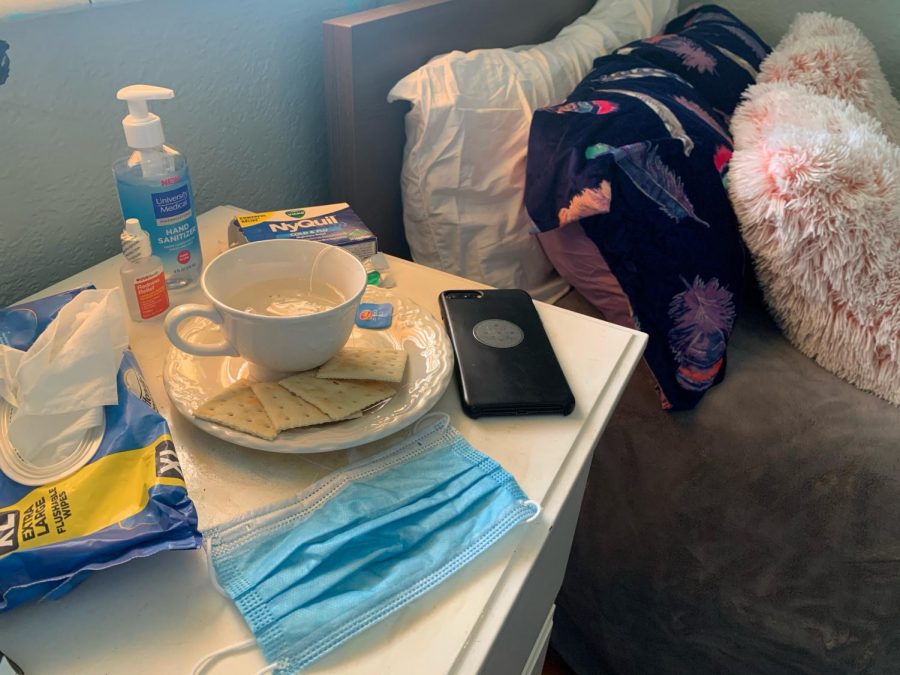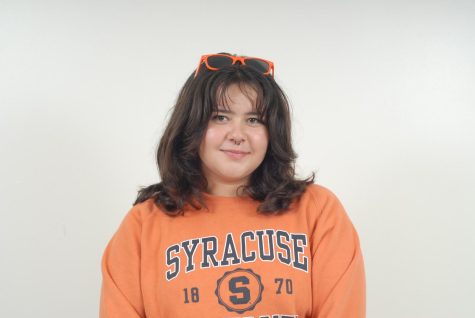1 out of 42,193*
*at the time of publishing this was the number of Coronavirus cases in K-12 schools in Florida
Tea, hand sanitzer, tissues and my phone. All things that helped me get through my bought with COVID-19.
November 9, 2020
Waking up one morning, I felt light headed and weak. My dry throat was begging for water. But, I didn’t think much of it.
A few days passed, and it started to get worse and worse. My throat was parched, my nose was runny, my body was aching, and I got pains that I can’t even explain. That’s when I started to get worried. Even with a fever, this feeling wasn’t how I normally felt when I was sick before.
Before I got sick, we had just come back from staying at a hotel near the beach for my mom’s birthday. My family had invited a few close family friends, we didn’t even think of social distancing, none of us seemed sick so we all thought it was okay.
I thought to myself, “What’s the worst that can happen?”
With a sinking feeling, I remembered the family celebration for my mom at the beach the week before. Stir crazy from COVID isolation, eight family members had gathered at the beach. We hugged, laughed and ate cake together. I thought I might have contracted the Coronavirus. I went to my mom with my concerns. she kept telling me it was just a fever and I was overreacting.
“Oh honey, it’s just a fever you’re overreacting.”
The rest of my family seemed perfectly fine.
I convinced my family to get tested, but my mom kept telling us that our family was never going to get it because we are healthy eaters and have good immune systems. At the time, they seemed like valid reasons.
Two days after I got tested for COVID, my results came in: positive. I was shocked. It felt surreal.
We got in contact with our family friends that we stayed with at the beach. It turned out my older sister, my brother in law and my step sister all got COVID.
The Florida Department of Education pushed for schools state-wide to move open schools to receive students for e-learning on campus. That means by October 15th, young teens can once again be on campus. Many are in disagreement with said actions, however there are many several students planning to attend.
On Sept. 15, the Sun Sentinel reported that 23% of new cases in Broward county could be attributed to young adults and teens. At the time of publishing, acording to the independanly run COVID Monitor, there were more than 42,000 reported cases of COVID-19 in K-12 schools. And that was just as Miami-Dade and Broward counties, the largest school districts in Florida, opened their doors to in-person classes.
“We have to make young teens realize that this isn’t a hoax, social distancing and wearing a mask is important throughout this pandemic. We are all in this together,” said Belia Jackson, a pediatrician at Memorial Hospital.
I was part of the problem and that hurt me the most. I was ignorant enough to think I was “immune” to corona. I learned the hard way that I was not.
I personally experienced most symptoms, loss of taste and smell, fever, body aches, headaches, and runny nose. However, asymptomatic people don’t experience any symptoms, so they are unaware that they might have the virus. Even though they don’t show any illness, it can still spread to others through contact. This can be dangerous as it puts them at risk.
Dr. Jackon thinks that teens aren’t ready to go back to school, and I couldn’t agree with her more.
It took me three weeks to recover from COVID. Many were painful days, others were just Irritating. I don’t recommend getting this virus. You usually don’t believe it until you experience it, but trust me it’s not worth the risk.




Athenea allen • Dec 2, 2020 at 7:37 pm
This is very well written and I will most definitely be taking more precautions
Athenea allen • Oct 26, 2020 at 6:24 pm
This story was really well written and I’m sorry you had to go through that but I’m glad you are better now and I will be definitely taking more precautions towards the virus
keyriandrea • Oct 23, 2020 at 9:03 pm
wow this story is really amazing. explains everything on how it went for her i found it very useful hearing a person view from this.
Fredrick Ortiz • Oct 23, 2020 at 8:31 pm
Wow that’s crazy how life works because one minute your completely normal and healthy and the next out of no where your about to die that’s crazy
John • Oct 23, 2020 at 6:20 pm
Its scary getting a positive test back… but what if that test is false? Watch out for my story coming soon about the reliability of Covid-19 tests
sydneystoyer • Oct 23, 2020 at 8:41 am
Wow, your experience seems very uncomfortable. There’s so many people who don’t take the virus seriously, and i think your story well represents why they should.
Markalya Lee • Oct 22, 2020 at 3:40 pm
The story is very good . And it sounded like what you went through was terrible . And makes me think maybe I should be more careful .
SamanthaG • Oct 22, 2020 at 9:37 am
This story was very good well detailed and how in depth the student went through their experience on having the virus
hopesilver • Oct 22, 2020 at 9:02 am
The story is very well written. I like how you spoke of your experience with corona virus and the symptoms you had from it. I also like how you felt like you couldn’t get it but did as that is the mindset of many young people who end up contracting the virus. Great job!
Natalie Diegue • Oct 21, 2020 at 12:28 pm
It’s sounds like a hard experience you went through.
Amelia Petrello • Oct 21, 2020 at 10:48 am
I’ll definitely be more careful after reading this..
emmygrace • Oct 21, 2020 at 10:43 am
Wow. I know some friends who feel like you did before you got the virus. They aren’t too worried because they don’t think they will get it, or that they will be fine if they do. I’m going to share this with some of them in hopes for them to understand how important it is not to take part in the spread of the virus.
LizzR • Oct 21, 2020 at 10:01 am
Great story! No one ever really believes something life threatening can happen to them until it does. Personally no one around me or myself has gotten covid, thankfully. I’m very glad that your body was able to pull together and fight off the disease. I would love to hear an update about your family members that also contracted covid-19
SamanthaG • Oct 20, 2020 at 9:59 am
This story really showed the depths of how the virus impacted most people’s lives and I’m glad that this student was willing to share their experience on how they felt and thought.
SamanthaG • Oct 20, 2020 at 9:56 am
This story showed a lot of details and the experience this student went through having the virus. I found it very informative how they presented their experience in their story.